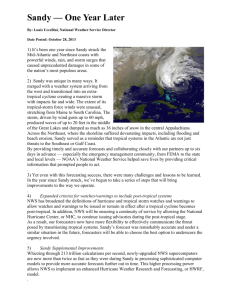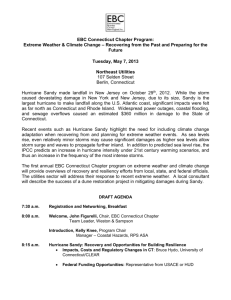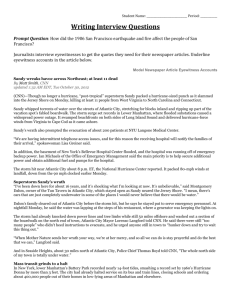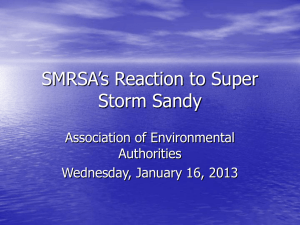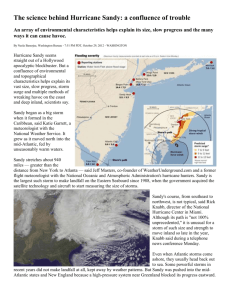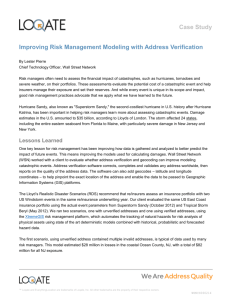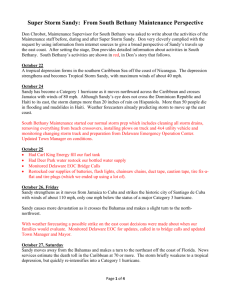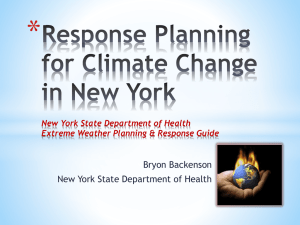Superstorm Sandy at the Jacques Cousteau National
advertisement
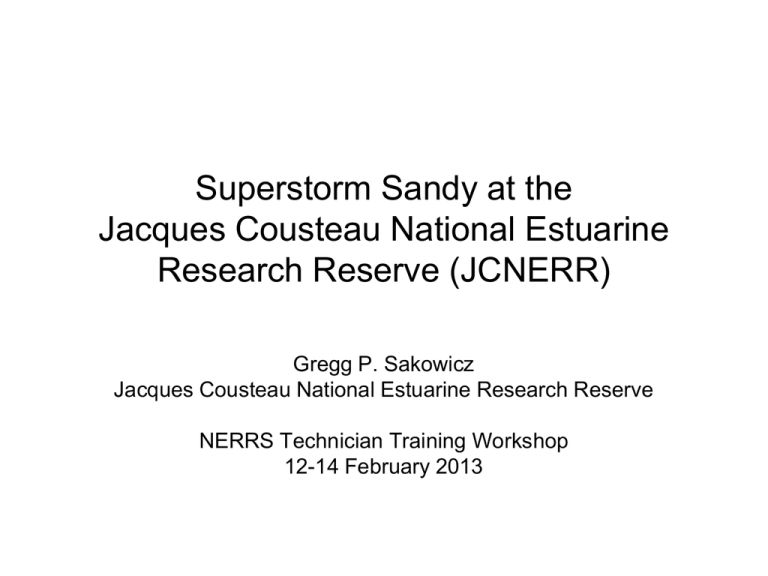
Superstorm Sandy at the Jacques Cousteau National Estuarine Research Reserve (JCNERR) Gregg P. Sakowicz Jacques Cousteau National Estuarine Research Reserve NERRS Technician Training Workshop 12-14 February 2013 Superstorm Sandy • Landfall Monday October 29th, 2012 at 7PM in Atlantic City, NJ. • Second-largest Atlantic tropical cyclone on record (Hurricane Olga set the record in 2001) • Strengthened under –PNA • Took a very atypical path due to a strong –NAO PNA (Pacific/North American Teleconnection Pattern) • Associated with the strength and location of the East Asian Jet Stream • Affects movement of weather systems and development of tropical systems +PNA (exaggerated for illustrative purposes) Cold air H tropical development hindered -PNA (exaggerated for illustrative purposes) L tropical development supported Warm air Image credit: NOAA Climate Prediction Center North Atlantic Oscillation (NAO) • Controls strength and direction of Westerly winds and storm tracks across North Atlantic • +NAO leads to increased westerly winds, Arctic air corralled at high latitudes • -NAO suppresses westerly winds, causes Jet Stream to meander, and sets up conditions for a “blocking high” over Greenland +NAO (exaggerated for illustrative purposes) systems move quickly, offshore Bermuda High -NAO (exaggerated for illustrative purposes) Blocking High systems pushed towards coast and strengthen How did the PNA and NAO interact with Sandy? • A -PNA set up conditions for tropical development • Conditions associated with -NAO blocked escape and pushed her towards the Eastern Seaboard Hurricane vs. Superstorm Designation • Hurricane Sandy (Cat 1) hybridized with a Nor’easter developing over the Northeastern seaboard and went “extratropical” – “Warm core” vs. “cold core” – Similar mechanism as 1991 “Perfect Storm” • Despite this reclassification, barometric pressure (940mmHg) was characteristic of a Category 3 or 4 hurricane • Winds did not significantly weaken and storm actually grew before making landfall Why Was Damage So Severe? • Size of storm maximized surge • Track of storm maximized surge • Maximum surge arrived with high-tide under full moon • Pressure-driven storm surge magnified by low bp • Debris and jetsam caused mechanical damage • Over-confidence (“The Irene-effect”) • Declassification confused public and officials Why Was Damage So Severe? (continued) • Rain runoff stacked more water on top of surge in bays • Wind strength created significant waves even in sheltered waters • Wind-shift to SSW after eye passage drove water into bayside communities and South-facing corners and coves in bays • Etc. etc. etc. • Call to evacuate was delayed (in my opinion) NOAA’s GFS model vs. the others Sandy in the JCNERR As seen through SWMP (System-Wide Monitoring Program) Nacote Creek Weather Station • The NC weather station captured Sandy’s effects and survived the storm • Recorded barometric pressure of 946mmHg • Peak wind speed of 25.6m/s (57.3mph) • Rainfall high in SNJ, less northward Wind Speed Rainfall Four days Rainfall = 138.2 mm = 125.0 mm Four days Water-Quality Stations • All 4 station datasondes survived(ish) the storm • Telemetry at B6 transmitted data live through the event • Telemetry station at NE was lost Water Quality Stations • Sandy’s surge stacked the following water ON TOP OF the already-high tides at each station: – – – – Buoy 126: Buoy 139: Chestnut Neck: Lower Bank: 1.3m (4.3ft.) 1.2m (3.9ft.) 1.3m (4.3ft.) 2.0m (6.6ft.) (All values approximate) How did the JCNERR Fair? • Relatively natural system - Populated areas in striking contrast vs. natural • Storm surge protected marsh surface • Hard, vertical features and structures bore brunt of impact • Some bank erosion and habitat loss • Underwater effects yet to be studied RUMFS RUMFS RUMFS RUMFS RUMFS Holgate & Forsythe Reserve Holgate & Forsythe Reserve Holgate & Forsythe Reserve Little Beach Little Beach Parson’s Clam Hatchery Parson’s Clam Hatchery Tuckerton Cove Tuckerton Cove Future Work • Analysis of Satellite and LiDAR imagery Future Work Future Work In Summary • Preliminary assessment of the reserve is favorable • The JCNERR’s SWMP stations captured Sandy as intended* • Data will be useful in studies examining how the environment and organisms recover from this event • Data are comparable to that collected at other NERRs • Data are available for download at www.nerrsdata.org
